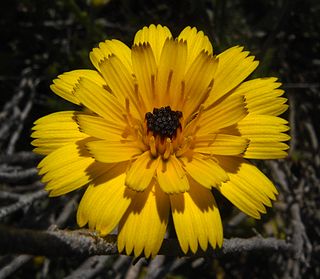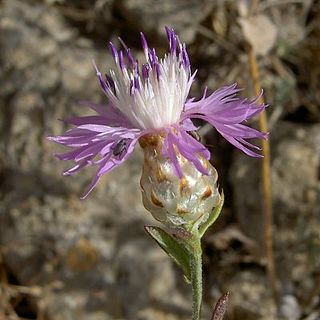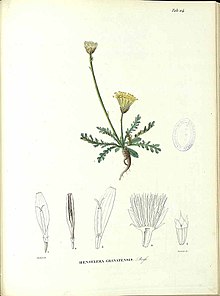
Senecio is a genus of flowering plants in the daisy family (Asteraceae) that includes ragworts and groundsels.

Tagetes is a genus of annual or perennial, mostly herbaceous plants in the family Asteraceae. They are among several groups of plants known in English as marigolds. The genus Tagetes was described by Carl Linnaeus in 1753.

Anthemis is a genus of aromatic flowering plants in the family Asteraceae, closely related to Chamaemelum, and like that genus, known by the common name chamomile; some species are also called dog-fennel or mayweed. Anthemis are native to the Mediterranean region and southwest Asia east to Iran. A number of species have also become naturalized in the United Kingdom and other parts of the world.

The genus Carthamus, the distaff thistles, includes plants in the thistle family. The group is native to Europe, North Africa, and parts of Asia. The flower has been used since ancient times in the Philippines, which it has been called kasubha by the Tagalog people.
Athroisma is a genus of plants in the family Asteraceae first described as a genus in 1833. It is native to East Africa and Madagascar.
Oblivia is a genus of flowering plant in the tribe Heliantheae within the family Asteraceae.

The Cichorieae are a tribe in the plant family Asteraceae that includes 93 genera, more than 1,600 sexually reproductive species and more than 7,000 apomictic species. They are found primarily in temperate regions of the Eastern Hemisphere. Cichorieae all have milky latex and flowerheads that only contain one type of floret. The genera Gundelia and Warionia only have disk florets, while all other genera only have ligulate florets. The genera that contain most species are Taraxacum with about 1,600 apomictic species, Hieracium with about 770 sexually reproducing and 5,200 apomictic species, and Pilosella with 110 sexually reproducing and 700 apomictic species. Well-known members include lettuce, chicory, dandelion, and salsify.

Pius Font i Quer was a Catalan botanist, pharmacist and chemist.
Isocarpha (pearlhead) is a genus of flowering plants in the family Asteraceae. They are native to Mexico, Central America, the West Indies, and northern South America, with the range of one species extending north into the United States.
Arrojadocharis is a genus of flowering plants in the family Asteraceae.
Platypodanthera is a genus of plants in the tribe Eupatorieae within the family Asteraceae.

Tolpis is a genus of flowering plants in the tribe Cichorieae within the family Asteraceae. It is native to Africa, Southern Europe, the Middle East and Macaronesia. Many species are limited to the Canary Islands.

Eclipta is a genus of flowering plants in the family Asteraceae.

Schlechtendalia is a genus of South American plants in the tribe Barnadesieae within the family Asteraceae. It is known in Portuguese as bolão de ouro, meaning "gold bullion". It is a perennial herbaceous plant, with rigid, linear leaves with a pointy tip. The corollas of the florets are yellow, and of the subbilobiate type, with four lobes merged into a strap, but split into teeth over half as deep, and one lobe free. This species flowers from September to December and the fruits are ripe in January or February. The only known species is Schlechtendalia luzulifolia, native to southern Brazil, Uruguay, northern Argentina. This species has sixteen chromosomes (2n=16).

Leucanthemopsis is a genus of flowering plants in the daisy family.
Neojeffreya is a genus of Malagasy flowering plants in the family Asteraceae.

Andryala is a genus of flowering plants in the daisy family. It is native to Europe, North Africa, and the Middle East.
Werner Walter Hugo Paul Rothmaler was a German botanist and from 1953 until 1962 head of the Institute for Agricultural Biology of the University of Greifswald. His areas of expertise included plant geography and systematics.

Centaurea alba is a species of Centaurea found in the Iberian Peninsula in southern and central Spain and in a small neighbouring area in the interior of Portugal. There are three recognised subspecies, and of one subspecies, the nominate, there are furthermore three varieties.
Erodium astragaloides is a species of flowering plant in the geranium family Geraniaceae. It is endemic to Sierra Nevada, southern Spain.












